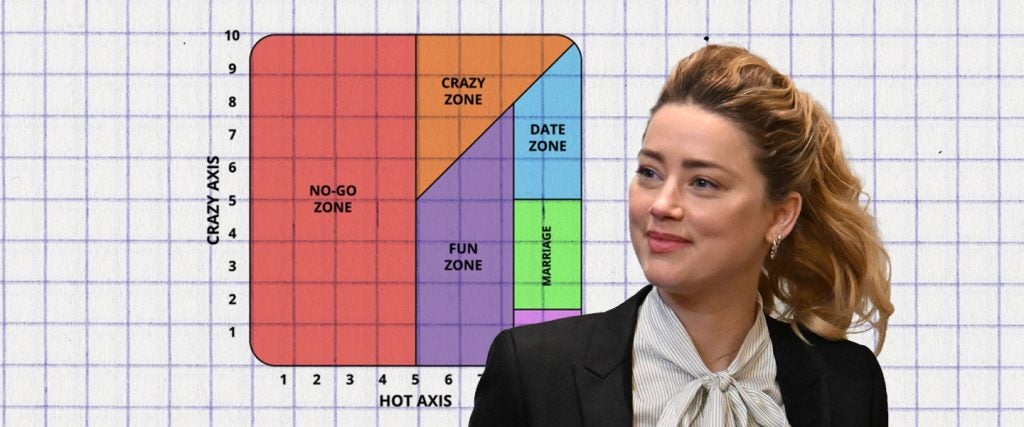There’s a simple matrix, potentially originating from the internet, How I Met Your Mother or some combination of the two, that states that a woman’s appeal is based on her hotness and craziness alone. A woman who is 10 out of 10 crazy is tolerable to date if she is 10 out of 10 hot, too. Similarly, a woman who is, say, 6 out of 10 hot may compensate for her missing hotness points by being only 4 out of 10 crazy. Place these traits on a chart, where the X-axis serves for craziness and the Y-axis represents hotness, and you’ll have what’s known as the Crazy/Hot Matrix.
This matrix has been passed around online for years, gaining prominence after being explained in detail in the third season of How I Met Your Mother in 2007, as well as in viral YouTube video and meme form. Lately, however, it’s become popular once more thanks to both an online quiz that identifies your location on the chart and the discourse surrounding the Johnny Depp/Amber Heard trial. On Twitter, some are saying Heard sits at the upper right corner of peak crazy, peak hot on the matrix.
Historically, the matrix has presented various “zones” to reference. For example, any woman beneath a five on the hotness axis is in the “no-go zone,” regardless of craziness, while a woman between a five and an eight on the hotness axis and a five and an eight on the craziness axis sits in the “fun zone,” so long as her craziness isn’t higher than her hotness. A woman of that hotness who is beneath a two on the craziness axis is said to be a unicorn, and essentially doesn’t exist.
Inherent in this matrix is the belief that the hotter the woman is, the crazier she’s allowed to be — and moreover, the crazier she’s likely to be. Notably, some versions of the matrix also posit that no woman is beneath a four on the crazy axis, and it actually begins at four instead of zero. Many of these versions also have a zone beneath “unicorn,” where a woman is eight to 10 on the hotness axis and less than four (or zero, in other words) on the craziness axis. This, horrifically, is labeled “tr*nny.*
The quiz version going around is a gender-neutral option that removes the slur and suggestion that a person’s hotness is correlated with their craziness, but other aspects of the matrix remain. The quiz, which is offered by a website called IRD Labs, offers 20 statements like, “I have tried online dating or mobile app dating, without getting many matches,” and “I have repeatedly destroyed my possessions or thrown out valuable things that I own because I felt I was worthless and did not deserve them.” Respondents then answer on a sliding scale whether they agree or disagree. While the statements are given in random order, they don’t vary among participants.
Because it’s only a 20-part questionnaire, it isn’t necessarily the most accurate arbiter of where one sits on the matrix, particularly in terms of hotness. By saying that I’ve had success online dating, think team sports build character and have experienced people go out of their way to be nice or perform favors for me, I was identified as a 10 out of 10 on the hotness axis. For craziness, I was given 6 out 10 (though a few re-takes brought me down to 5 out of 10), or within the “dating zone.”
Now, look, I’m not going to complain about being called a 10, and 5 or 6 out of 10 on the crazy scale seems reasonable. The quiz in its current form is relatively harmless and arbitrary, too — while “crazy” is so carelessly thrown around in reference to women, the questions in the quiz do seem relatively balanced. But the earlier forms of the matrix point to the underlying assumptions about women that inform it. In versions that include the “tr*nny” portion, the orange “danger zone” of women who are crazier than they are hot labels “redheads, strippers, girls named Tiffany” and “hairdressers” among women in this category. Sure, it’s a joke, but not a very insightful one.
Beyond that, though, maybe hotness and craziness really are the only two factors that matter, particularly if you see intelligence, kindness or other important qualities as ultimately shaping how you perceive someone’s hotness and craziness, too. On the other hand, this points to how both hotness and craziness seem to be continually shifting targets. Take someone like Pete Davidson — would we see him as being as hot as we do if we didn’t know his personality? And doesn’t his “craziness,” i.e. openness about his mental health, influence that hotness in some form, too?
Nevertheless, despite its flaws, the Crazy/Hot Matrix has persisted as a guiding reference for at least the last 15 years. Perhaps our standards change, but the math of the matrix may always ring true.

